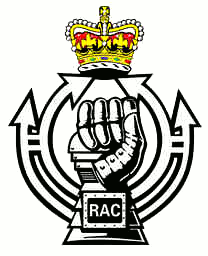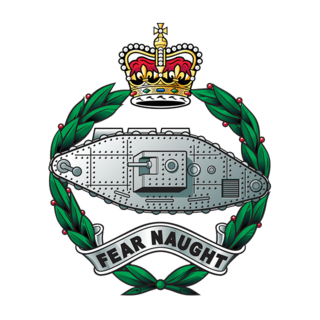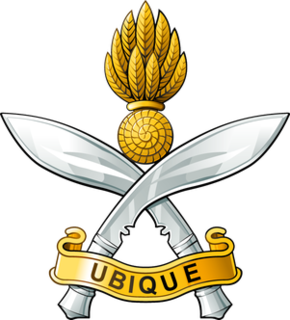
The Royal Armoured Corps is the component of the British Army, that together with the Household Cavalry provides its armour capability, with vehicles such as the Challenger 2 Tank and the Scimitar Reconnaissance Vehicle. It includes most of the Army's armoured regiments, both the Royal Tank Regiment and those converted from old horse cavalry regiments. Today it comprises twelve regiments, eight regular and four reserve. Although the Household Cavalry Regiment provide an armoured regiment, they are not part of the RAC.

The King's Royal Hussars (KRH) is a Royal Armoured Corps regiment of the British Army formed in 1992. Based at Tidworth it serves as the armoured regiment of the 12th Armoured Infantry Brigade. Under Army 2020 Refine, it is intended to exchange its Challenger 2 tanks for Ajax vehicles.

The Household Cavalry Regiment (HCR) is an Armoured Cavalry regiment of the British Army based in Bulford Camp in Wiltshire. It is the brother regiment of the Household Cavalry Mounted Regiment (HCMR) based at Hyde Park Barracks in London - both regiments together form the Household Cavalry (HCav). The Household Cavalry was formed in 1992, under the Options for Change reforms, by the union of The Life Guards and the Blues and Royals in order to preserve the distinct identities of the regiments. A precedent for the Household Cavalry Regiment has previously been set by the Household Cavalry Composite Regiment - active during the Anglo-Egyptian War, the Second Boer War and latterly during both the First and Second World Wars.

The 2nd Royal Tank Regiment was an armoured regiment of the British Army. It was part of the Royal Tank Regiment, itself part of the Royal Armoured Corps and the 1st Mechanized Brigade.

The 1st Armoured Infantry Brigade is an infantry brigade of the British Army with a long history including service during both the First and the Second World Wars. It is based at Tidworth Camp. Previously, it has been designated 1st (Guards) Brigade, 1st Infantry Brigade, 1st Mechanised Brigade, and under the initial Army 2020 reforms assumed the title of 1st Armoured Infantry Brigade. Under the Future Soldier programme, the brigade will merge with 1st Artillery Brigade to form 1st Deep Recce Strike Brigade Combat Team.

The 20th Armoured Brigade Combat Team, previously the 20th Armoured Infantry Brigade, is an armoured infantry brigade formation of the British Army, currently headquartered at Wing Barracks, Bulford, Wiltshire, as part of the 3rd Division.

The 11th Security Force Assistance Brigade is a brigade of the British Army which is intended to train and assist foreign forces. In 2021, under the Future Army changes, the brigade was redesignated, formerly being the 11th Infantry Brigade & HQ South East. Prior to the Army 2020 changes in 2013, the brigade was temporarily activated for deployment to Afghanistan, and before that engaged during the two World Wars.
1st Regiment Royal Horse Artillery is a regiment of the Royal Horse Artillery in the British Army. It currently serves in the armoured field artillery role, and is equipped with the AS90 self-propelled gun. The regiment is currently based at Larkhill Garrison, Larkhill. The Regiment completed its move from Assaye Barracks, Tidworth to Larkhill in June 2019.

23 Parachute Engineer Regiment is a Royal Engineers regiment in the British Army that was formed in 2003. It provides engineer support to 16 Air Assault Brigade in both the parachute and air assault role. The regiment is currently based at Rock Barracks in Suffolk and consists of three regular squadrons and one Army Reserve squadron. As part of 16 Air Assault Brigade it can be called upon to deploy on operations across the globe at extremely short notice.

Swinton Barracks is a military installation accommodating two engineer regiments at Perham Down in Wiltshire, England. The site is on the east edge of Salisbury Plain, about 1+1⁄2 miles (2.4 km) east of the garrison at Tidworth. The camp forms part of the Tidworth, Netheravon and Bulford (TidNBul) Garrison.

3 Regiment Army Air Corps is the British Army's Divisional deep attack Aviation Battle Group, operating the WAH-64D Apache attack helicopter.
26 Engineer Regiment is a regiment of the British Army's Royal Engineers. It is based at Swinton Barracks, Salisbury Plain, Wiltshire.
32 Engineer Regiment is a regiment of the British Army's Royal Engineers.

The 36 Engineer Regiment is a regiment of the Corps of Royal Engineers within the British Army. The regiment trace their history back to before World War II as 36 Army Engineer Regiment. The regiment today is a general support engineer regiment provided force support within 12 Engineer Group.

Tidworth Camp is a military installation at Tidworth in Wiltshire, England. It forms part of the Tidworth, Netheravon and Bulford (TidNBul) Garrison.

The structure of the British Army of the United Kingdom (UK) will be reorganised in 2022 with the Future Soldier reform. The British Army is commanded by the Chief of the General Staff (CGS), with Army Headquarters which is located in Andover, Hampshire. Subordinate to that post, there is a Commander Field Army, and a personnel and UK operations command, Home Command.

Barker Barracks was a military installation in Paderborn, Germany.
28 Engineer Regiment (C-CBRN), Royal Engineers is a regiment of the British Army that focuses on countering chemical, biological, radiological and nuclear (C-CBRN) hazards in the environment. Its operational chain of command is 29 Group, under 8th Engineer Brigade as part of 1st (UK) Division.

The 1st Field Engineer Squadron is an engineer unit of the Corps of Royal Engineers within the British Army. The squadron was first formed in 1914 following the mobilisation of the Army for the First World War. The squadron later supported The Cavalry Division and the first British Army of the Rhine. The squadron later saw service in the Second World War and today supports the 21st Engineer Regiment of the new 1st Strike Brigade.
Future Soldier is a reform of the British Army resulting from the Integrated Review of Security, Defence, Development and Foreign Policy published in March 2021. The aim of the reform is to create a more lethal, agile and expeditionary force, able to fight and win wars and to operate in the grey-zone between peace and war. Future Soldier was published on 25 November 2021 and deals with the organizational changes of the British Army, with changes to personnel and equipment were set out in the Defence in a Competitive Age paper published on 22 March 2021.














